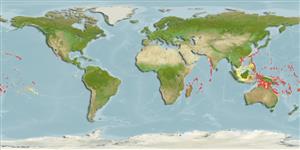Preferred temperature (Ref.
123201): 24.8 - 28.9, mean 27.5 °C (based on 362 cells).
Phylogenetic diversity index (Ref.
82804): PD
50 = 0.5000 [Uniqueness, from 0.5 = low to 2.0 = high].
Bayesian length-weight: a=0.00692 (0.00311 - 0.01538), b=3.06 (2.88 - 3.24), in cm total length, based on LWR estimates for this Genus-body shape (Ref.
93245).
Nível Trófico (Ref.
69278): 3.5 ±0.5 se; based on diet studies.
Resiliência (Ref.
120179): Elevada, tempo mínimo de duplicação da população menor que 15 meses (Preliminary K or Fecundity.).
Fishing Vulnerability (Ref.
59153): Low vulnerability (10 of 100).
Nutrients (Ref.
124155): Calcium = 95.2 [51.7, 147.6] mg/100g; Iron = 0.671 [0.421, 1.087] mg/100g; Protein = 18.1 [15.8, 20.0] %; Omega3 = 0.102 [0.062, 0.171] g/100g; Selenium = 31.5 [16.8, 60.9] μg/100g; VitaminA = 96.9 [34.2, 264.8] μg/100g; Zinc = 1.51 [1.04, 2.10] mg/100g (wet weight);
